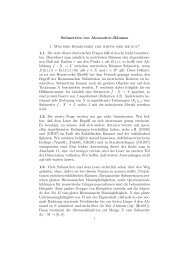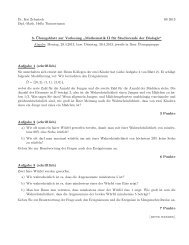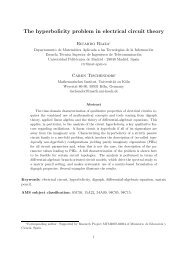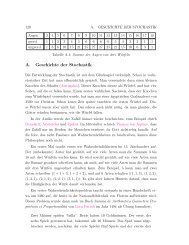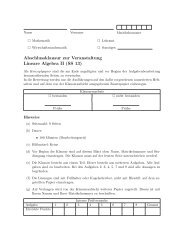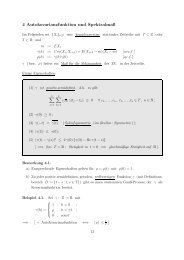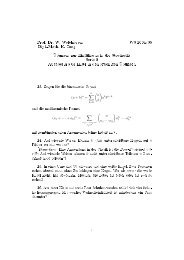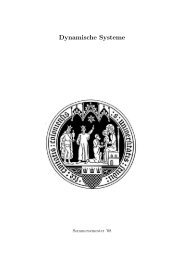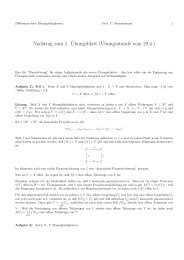Inhaltsverzeichnis - Mathematisches Institut der Universität zu Köln
Inhaltsverzeichnis - Mathematisches Institut der Universität zu Köln
Inhaltsverzeichnis - Mathematisches Institut der Universität zu Köln
You also want an ePaper? Increase the reach of your titles
YUMPU automatically turns print PDFs into web optimized ePapers that Google loves.
DMV Tagung 2011 - <strong>Köln</strong>, 19. - 22. September<br />
Albert Granados, John Hogan, Tere Seara<br />
<strong>Universität</strong> Stuttgart, University of Bristol, Universitat Politècnica de Catalunya<br />
Melnikov’s method for subharmonic orbits in a piecewise-defined Hamiltonian system with<br />
impacts<br />
In this work we consi<strong>der</strong> a two-dimensional piecewise smooth system, defined in two sets separated<br />
by the switching curve x = 0. We assume that there exists a piecewise-defined continuous Hamiltonian<br />
that is a first integral of the system. We also suppose that the system possesses an invisible fold-fold at<br />
the origin and two heteroclinic orbits connecting two critical saddle points located at each side of x = 0.<br />
Finally, we assume that the region closed by these heteroclinic connections is fully covered by periodic<br />
orbits surrounding the origin, whose periods monotonically increase as they approach the heteroclinic<br />
connection.<br />
When consi<strong>der</strong>ing a non-autonomous (T -periodic) Hamiltonian perturbation of amplitude ε, using an<br />
impact Poincaré map, we rigorously prove that, for every n and m relatively prime and ε > 0 small enough,<br />
there exists a nT -periodic orbit impacting 2m times with the switching curve at every period. In addition,<br />
we also prove that, if the orbits are forced to un<strong>der</strong>go a discontinuity when they cross x = 0, which<br />
simulates a loss of energy, then all these orbits persist if the relative size of ε > 0 with respect to the<br />
magnitude of this jump is large enough.<br />
Hany A. Hosham<br />
<strong>Universität</strong> <strong>zu</strong> <strong>Köln</strong><br />
Nonstandard bifurcation phenomena in nonsmooth system<br />
Due to the presence of discontinuities on the manifold, nonsmooth system (PWS) present a wide variety<br />
of bifurcations. In particular, if the behavior of PWS relies on the dynamics of the separation boundaries,<br />
nonstandard bifurcations may occur. It was recently shown that the existence of invariant cones C plays<br />
an important role in describing the dynamical behavior for PWS relevant to the transition law between<br />
the subsystems. The sliding dynamics along the separation manifold for PWS are formulated by using<br />
differential inclusions. We show the existence of C containing a segment of sliding orbits and study stability<br />
on these cones. Our approach is developed to investigate the existence of C induced sliding bifurcation.<br />
Different sliding bifurcation scenarios such as: invariant cones exhibiting crossing-sliding, grazing-sliding<br />
and switching-sliding bifurcation are treated. Further, catastrophic bifurcation may occur.<br />
Literatur<br />
CFPT Carmona, V., Freire, E., Ponce, E., Torres, F. (2005). Bifurcation of invariant cones in piecewise<br />
linear homogeneous systems. Int. J. Bifur. Chaos, 15, 2469-2484.<br />
K Küpper, T. (2008). Invariant cones for non-smooth systems, Mathematics and Computers in Simulation,<br />
79 1396-1409.<br />
KH Küpper, T., Hosham, H. A. (2011). Reduction to invariant cones for non-smooth systems, special Issue<br />
of Mathematics and Computers in Simulation, 81 980-995.<br />
HKW Weiss, D., Küpper, T., Hosham, H. A. (2011). Invariant manifolds for nonsmooth systems, Physica<br />
D: Nonlinear Phenomena, to appear.<br />
174




